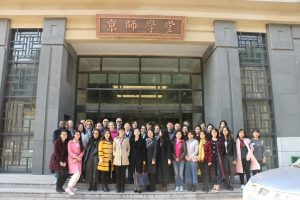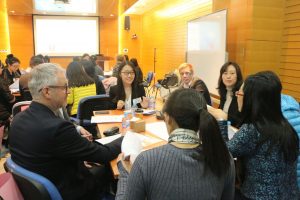The CICERO symposium overall goal today was to launch the new book ‘New Ways to Teach and Learn in China and Finland‘. My talk aimed to present our chapter and, by the way, I made a quick overview of our Digital Storytelling research experiences and insights. Our involvement with digital storytelling is not new. With the team of researchers at Cicero learning and with Hannele Niemi and Jari Multisilta as Principal Investigators at that time we have been investigating the way teachers integrate digital technologies into their professional practices and how the students use the technologies to build and exchange ideas, to ask questions, to experiment with language and in the lab, since 2012.
Throughout this time digital storytelling has been the glue to tie these projects together.
Digital Storytelling 1.0: The FINNABLE2020 -‘Boundless Classroom’ (2012-2014) project, whose aim was to seek new ways to connect formal and informal learning environments and encourage students’ active learning and knowledge creation with video stories. One of the goals was also to promote tools for knowledge sharing and to advance 21st century skills, especially problem solving and creativity. This phase involved diverse school environments in primary and secondary education in Finland, Greece and California.
Digital Storytelling draws from Global Sharing Pedagogy framework that was discussed by Hannele and Jari in their studies. The framework places the focus of interest on learners and one primary objective is to understand what factors interact for learner engagement in learning.
The second phase (2.0): ‘Video Inquiry Project: STEM Learning and Teaching with Mobile Video Inquiries and Communities’ (2013-2015) and was part of a joint Finnish-American project. This one aimed to create innovative tools and provide research findings supporting new pedagogical models that foster learners’ and teachers’ interests in and joint attention to the power of science and mathematics in explaining phenomena ‘in the everyday world’. The project activities took place in primary schools in Finland and California. In both projects, students created video stories collaboratively.
The third phase (3.0): the Sino-Finnish collaboration project (2015-2017) that aims to build bridges of collaboration at the academic and research level between the Finnish and Chinese Universities. Currently, we are working on our studies in China, reflecting upon our joint efforts with colleagues from PKU and BNU to introduce digital storytelling as a new way of thinking pedagogy and teaching practices in primary schools in Beijing.
Our involvement with digital storytelling is not new. With the team of researchers at Cicero learning and with Hannele Niemi and Jari Multisilta as Principal Investigators at that time we have been investigating the way teachers integrate digital technologies into their professional practices and how the students use the technologies to build and exchange ideas, to ask questions, to experiment with language and in the lab, since 2012.
Throughout this time digital storytelling has been the glue to tie these projects together.
Digital Storytelling 1.0: The FINNABLE2020 -‘Boundless Classroom’ (2012-2014) project, whose aim was to seek new ways to connect formal and informal learning environments and encourage students’ active learning and knowledge creation with video stories. One of the goals was also to promote tools for knowledge sharing and to advance 21st century skills, especially problem solving and creativity. This phase involved diverse school environments in primary and secondary education in Finland, Greece and California.
Digital Storytelling draws from Global Sharing Pedagogy framework that was discussed by Hannele and Jari in their studies. The framework places the focus of interest on learners and one primary objective is to understand what factors interact for learner engagement in learning.
The second phase (2.0): ‘Video Inquiry Project: STEM Learning and Teaching with Mobile Video Inquiries and Communities’ (2013-2015) and was part of a joint Finnish-American project. This one aimed to create innovative tools and provide research findings supporting new pedagogical models that foster learners’ and teachers’ interests in and joint attention to the power of science and mathematics in explaining phenomena ‘in the everyday world’. The project activities took place in primary schools in Finland and California. In both projects, students created video stories collaboratively.
The third phase (3.0): the Sino-Finnish collaboration project (2015-2017) that aims to build bridges of collaboration at the academic and research level between the Finnish and Chinese Universities. Currently, we are working on our studies in China, reflecting upon our joint efforts with colleagues from PKU and BNU to introduce digital storytelling as a new way of thinking pedagogy and teaching practices in primary schools in Beijing.
During this whole time, there have been several actors and networks involved, teachers, students, and digital stories made by students, while 2 web-based environments were developed. Movie (Mobile Video Experience) shifted from version 1.0 to 2.0, while EdVisto, a contemporary web-community-based platform, took in shape based on our research insights.
We have also published the findings of our studies and opened up our research experiences and insights in conferences in Europe, the US, China and elsewhere. In our studies, we have used quantitative and qualitative methods and tackled topics such as student engagement, learning with fun, the creative use of interactive web-based platforms, the use of technology for student initiative, the pedagogies of the future and others. In the New Ways to Teach and Learn we come up with a typology of student generated digital stories.
In our chapter: Student-driven knowledge creation through digital storytelling we discuss how it can be possible to break classroom boundaries with Digital stories. These can present different sets of events. Some focus on instances of the object of study and others present have more complex plots. While the former act like zoom-in lenses of the classroom narrative, the latter build up networks of actions. In both cases the students can act as storytellers and as characters. The characters of the stories can be real or fictional. Stories can have a close relationship with themes grounded in curricular requirements, or can be indirectly linked with it.
Overall, digital storytelling for student-driven knowledge creation produced subject-based, interdisciplinary and student-initiated stories in multimodal formats. These artifacts required both on-site and out-of-school settings to result in enriched and embodied learning experiences. 21st century learning outcomes, therefore, necessitated the development of multiliteracies and multimodalities as well as holistic and integrative approaches to teaching and learning.
Learning with digital storytelling, therefore, seems to be a dynamic and spiral, rather than linear, process.
Wrapping up this presentation: the findings of our research indicate that breaking the boundaries of formal learning entails the consideration of all aspects of sharing pedagogies globally: the content of learning, the medium of communication (whether linguistic or technological), willingness for collaboration and the confluence of networking resources for more diverse and flexible communication.
Digital storytelling in a Global Sharing Pedagogy framework, indeed, seems to be able to enrich the scope of formal learning experiences.
‘In order to survive, we should keep telling stories’ U. Eco
to be continued…







